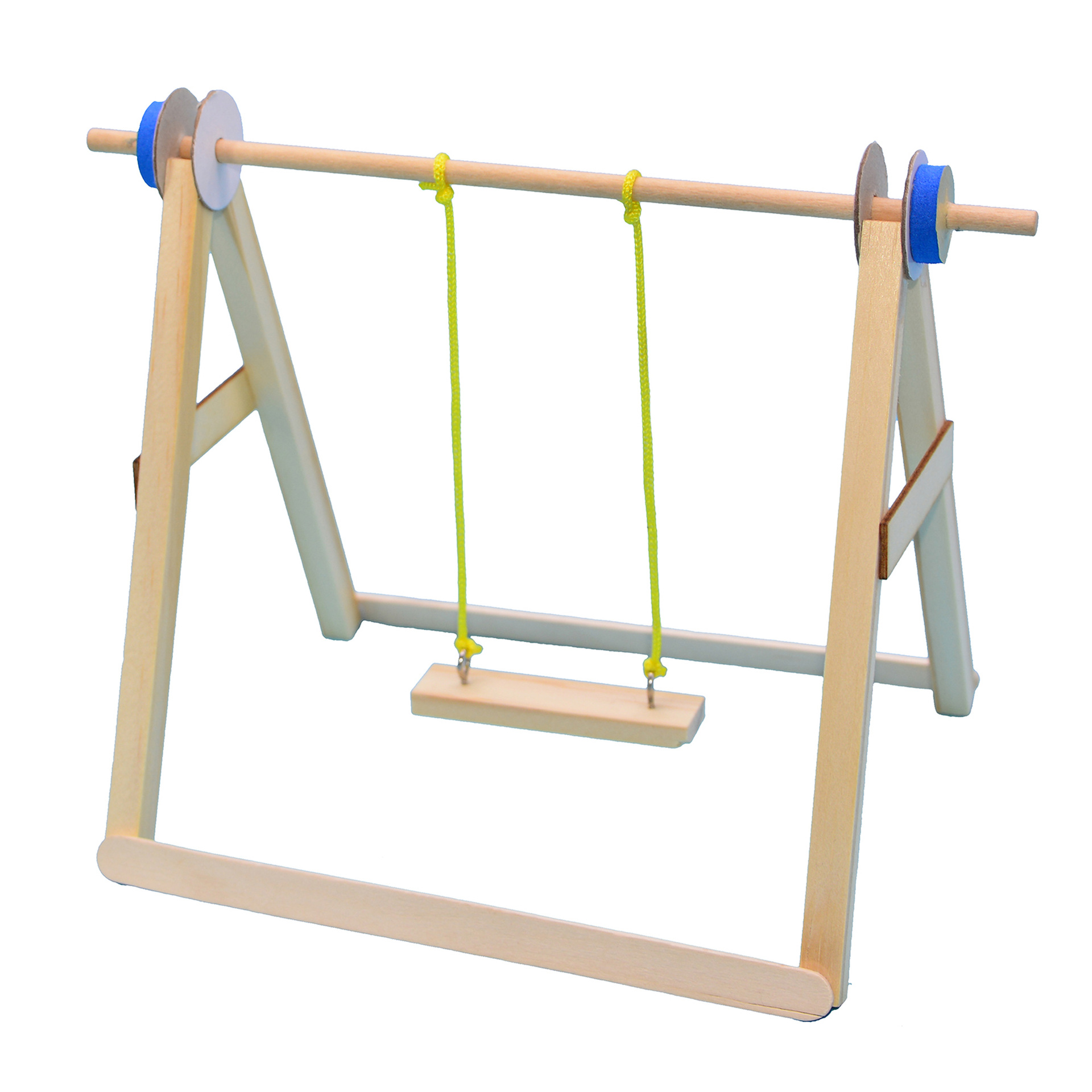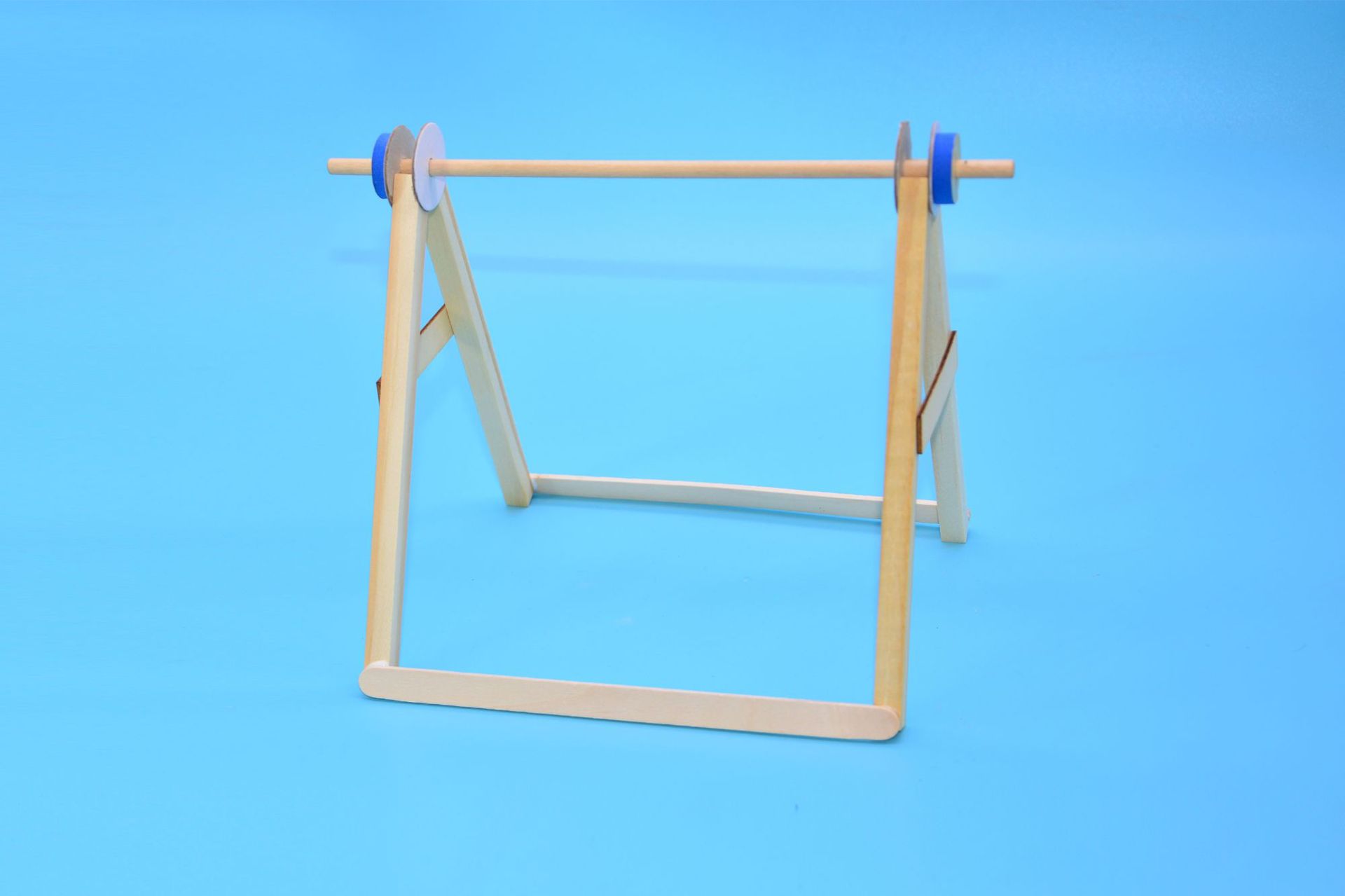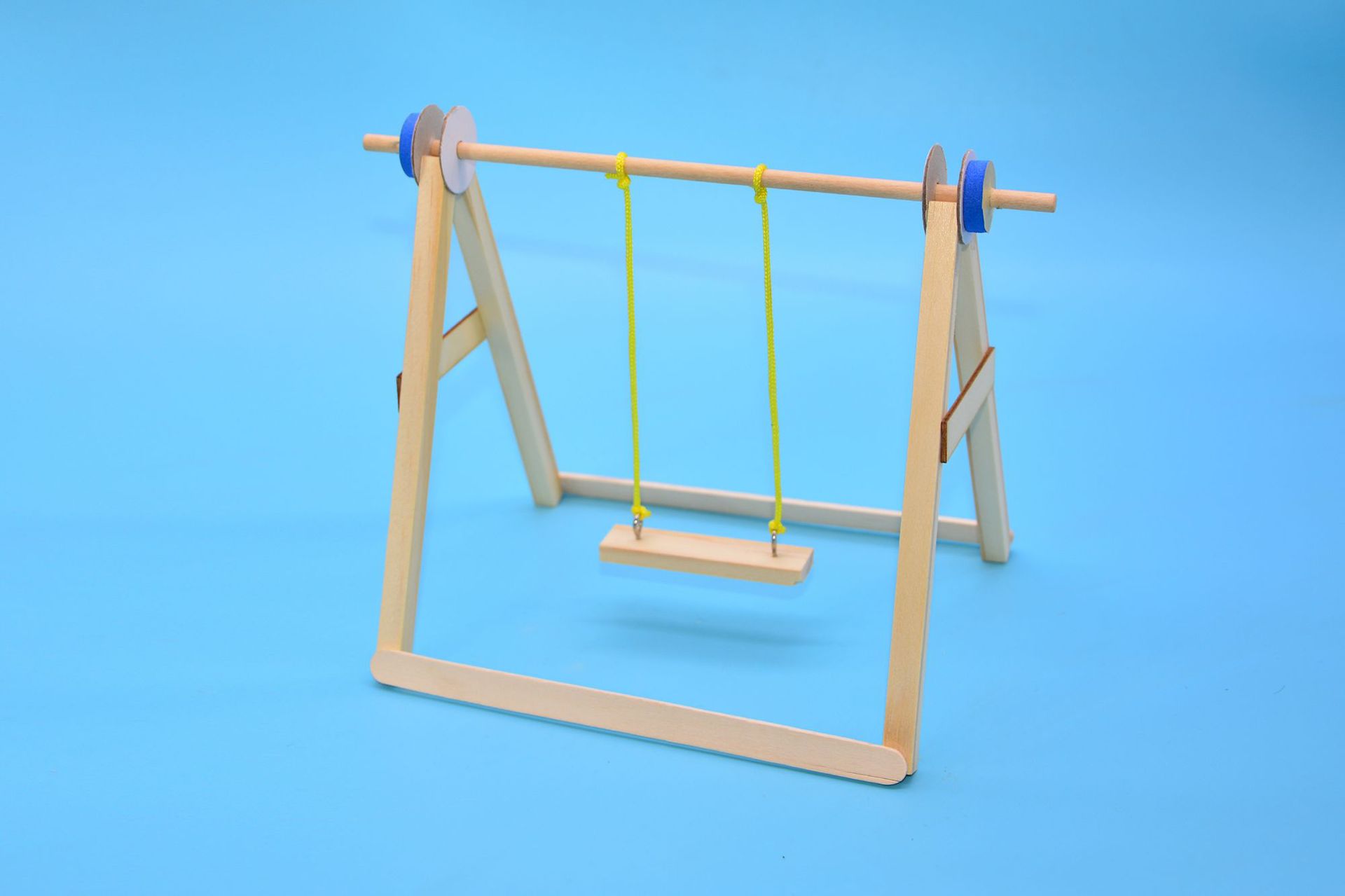
Search history
Clear allSearch by image
XDrag and drop an image here or upload an image
Max 5MB per image
UploadSign In | Join

Search history
Clear allSearch by image
XDrag and drop an image here or upload an image
Max 5MB per image
UploadSign In | Join
X Email Mobile
| Number | Unit-price | Total | |||
| I want to buy: | × | 6.62 | = | 0 |
A new item has been added to your Shopping Cart. You now have items in your Shopping Cart.
Direct factory quantity custom customer contact 15858994086 




Product Name: KX1934 Swing
Product code: Swing
Size: 210*130*155mm
Weight: About 80g
Material: Wood + Paper + Glue + Plastic Accessories + Rope
Color: Wooden color
Battery Required: No
Packing: 500pcs
Box Specification: 600*450*550mm
Swings, a type of playground equipment, are long ropes tied to a frame with boards at the bottom for people to step on and swing back and forth. Swings were created by ancient northern ethnic minorities in China. They were introduced to the Central Plains during the Spring and Autumn period. Due to their simplicity and ease of learning, swings became very popular and spread quickly throughout the region. After the Han Dynasty, swings gradually became a folk custom activity during festivals such as Qingming and Dragon Boat Festival and have continued to be passed down to the present day.

A swing is a mechanical system subject to two external forces: one is gravity pulling downward, and the other is a restraining force acting at the suspension point 0, always along the swing rope. We know that only when the external forces are continuously doing work on the system will the swing become higher and higher. The above two external forces, the restraining force, due to always being perpendicular to the direction of the swing's motion, do not do work. Only gravity does work during each back and forth swing, which means that gravity is "pushing" the swing.We know that the center of gravity of a person is higher when standing than when squatting. In other words, when using the above swing method, an upward swing has a higher center of gravity than a downward swing, and when swinging, the axis of the person is along the swing rope. This way, the moment of the force of gravity acting on the center of gravity is smaller when the swing is rising than when it is falling, so the total work done by the moment of one up and one down is positive. Since every round-trip of the system has energy input, the swing naturally becomes higher and higher. In short, whether it is a swing in any way, it is the work done by the external forces on the swing system. Or it will rise or maintain a certain height. However, for the external forces to do work on the swing, an important condition is that the external forces must push and pull in rhythm with the swing's swing rhythm. The swing has a rhythm, and the external forces have a rhythm, and the two rhythms must match for the swing to become higher and higher. This condition is also called resonance. The discussion above is about the swing as a sport. In fact, we often encounter many different types of "swing" in our daily lives."The swing" in the pendulum clock refers to the core component: a pendulum and a escapement. The lower part of the pendulum is a metal weight A, connected to the suspension point by a lever. Some clockmaking techniques simply turn the weight of the pendulum into a girl playing on a swing. The back and forth movement of the pendulum is exactly like a girl playing "swing". The power of the girl playing on the swing comes from a cleverly designed "escapement". The escapement B, driven by the spring or other power, rotates clockwise. The escapement fork C connected to the pendulum moves with the swing, allowing the escapement wheel to rotate through one tooth every time the pendulum returns. The clever design of the escapement wheel teeth and the escapement fork end shape is to allow the gear to "escapement" once by the power of the escapement wheel, as if someone is "pulling" the swing.The escapement wheel works on the pendulum, making it continue to swing. Otherwise, it will stop.








2 Basic Introduction
Chinese name: Swing
The purpose is for game equipment, where a long rope is tied to a frame, with stepping boards hanging below, allowing people to swing back and forth with the stepping boards.
3 Historical Origins
The origin of the swing can be traced back to several centuries.
swing
Ten thousand years ago in the ancient times. At that time, our ancestors needed to climb trees to pick wild fruits or hunt wild animals for a living. While climbing and running, they often held on to thick vines and relied on the swaying of the vines to climb trees or cross gullies, which was the original form of the swing. As for the later swing with a rope suspended from a wooden frame and a step tied below, it existed in our northern part of the country during the Spring and Autumn Period. There is a record in "Yi Wen Lei Ju" that "in the northern mountainous areas of the North, people used the swing as a game during the cold food festival." At that time, in order to make the rope of the swing more durable, it was often made of animal skins, so the characters for "swing" are often written with the radical "革".
4相关习俗
This is the custom of the ancient Qingming Festival in China. The word "kite" means to pull the skin rope and move it. Its history is very old, originally called "Qiuli," but later changed to "kite" to avoid taboos. In ancient times, the kite was often made with branches of trees as the frame, tied with colorful ribbons. Later, it gradually developed into a kite with two ropes and a step board.
Ancient swing was only seen around the time of Qingming Festival and Cold Food Festival, and it was limited to the games of young men and women from wealthy families.
5 types of swings
Fang Chuan
Swinging is a common amusement and competitive sport among many ethnic groups on the Chinese mainland. According to existing literature, it originated in the pre-Qin period.
The Ancient and Modern Art Picture says: 'This (playing on the swing) is a game of the northern mountain people, used to practice agility.' (See Zhai Hao's Popular Compilation, Volume 31 of the Qing Dynasty). The mountain people were an ancient ethnic minority in the north, with their territory in the areas around today's Beijing. The swing was originally a tool for their military training. After the first of the Five Hegemon-Kings, King Huan of Qi, led his troops to defeat the mountain people, he annexed their land to Yan State, and the swing spread southward with it. Later, it gradually evolved into a game tool.
Ancient swing
Swinging, later mainly became a game for women in the palace or in the private rooms, or a part of the traditional festival square carnival. During the reign of Emperor Wu of Han, swinging became popular in the palace. Gao Wudao, a Tang Dynasty poet, wrote in his poem "The Empress's Backyard Swing": "The swing is a thousand years. Emperor Wu prayed for a thousand years of life, so the empresses in the palace enjoyed the joy of swinging." The purpose of swinging at that time was mainly to maintain physical health. In the Tang Dynasty court, swinging was called "Half-Immortal Play." Wang Renyu, a writer of the Five Dynasties, wrote in his notes "Remnants of Kaiyuan and Tianbao": "In the palace during the cold food festival, they competed to set up swings, letting the palace ladies play and laugh as a party. The emperor called it the half-immortal play, and the citizens of the capital also called it."
Water Swing
During the Song Dynasty, the "water swing" appeared. According to records in books such as "Meng Liang Lu" by Wu Zimu from the Southern Song Dynasty, this type of acrobatic performance was held in both the capital of the Northern Song Dynasty, Bianliang in Jinming Pool, and the capital of the Southern Song Dynasty, Lin'an in the West Lake and the Qiantang River. Every summer, from the emperor and his consorts, the princes and ministers, to the common people, they all eagerly watched the performance. Before the performance, two beautifully carved boats were placed in the water, with high swing frames at the bow. During the performance, the drums on the boats were played loudly, and the acrobatic artists on the stern began with the pole tricks, followed by the performers taking turns climbing the swing, vigorously swinging back and forth. When the swing reached the level of the crossbeam of the swing frame, they let go of the ropes with both hands, using the rebound force of the swing to leap into the air, doing a somersault, and then diving into the water. Due to the different postures of the performers, the performance looked thrilling and beautiful, with endless changes. The "water swing" is similar to modern diving, which is a new development in Song Dynasty acrobatics and holds an important position in the history of Chinese acrobatics, with a significant impact on later generations.
After the Song and Tang dynasties, the custom of swinging on a swing became popular throughout the country, reaching an unprecedented scale.
Mofa Qiuchen
In the minority ethnic regions of southwest China, the traditional swing forms such as mokong and windmill swings are still popular.
The mokch'o can be divided into two types, one called the turning mokch'o, and the other called the mokch'o on a pole. The turning mokch'o has a central pillar with a shaft at the top, from which four ropes are attached, each with a ring at the end. Four people hold the rings and leap around the shaft, resembling the action of pushing a grinding stone, hence the name turning mokch'o.
The game of "Moudangqiu" involves the following steps: 1. A long, hard wood pole, 1-2 meters in length and about 15 centimeters in diameter, is fixed vertically on the ground. The top of the pole is sharpened into a shaft. 2. A second pole, about 10 meters long and with a diameter similar to that of the first pole, is selected. It is drilled with a concave in the middle and placed horizontally on the top of the upright pole, forming the "Moudangqiu" structure. 3. Equivalent numbers of people sit on both ends of the pole. After the riders slightly run with their feet on the ground, they quickly climb onto the pole or crawl on the top of the pole. 4. The pole then rotates like a grinding stone, with the two ends rising and sinking alternately, similar to the up-and-down movement of a bamboo pole when carrying a load, hence the name "Moudangqiu." 5. As the pole rotates and rises and falls, the side that lands on the ground uses their feet to add power, causing the pole to bounce back up. 6. This way, the pole alternates between rising and falling, rotating continuously.
The most popular of the Dai, Jingpo, Miao, Zhuang, Hani, Buhi, and Gelaos in Yunnan, Guizhou, Guangxi, etc., is the Hani tribe, which is typical.
The Hani people mainly celebrate the Mopan festival in the fifth lunar month or June. The fifth lunar month is celebrated on the day of the dog or the pig, known as "May Festival"; the sixth lunar month is celebrated on the 3rd to 5th day, known as "June Festival", which the Hani call "Kuzaza" Festival. "May Festival" and "June Festival" are both Mopan festivals. The origin of "May Festival" has a local legend: in ancient times, the sun and the moon moved irregularly, harming the crops. A Lang and A Chang, siblings, decided to help their neighbors. They cut down chestnut trees to support the Mopan, and as the Mopan spun, they flew to the sun and the moon. They tried their best to convince them to move in a regular pattern. Their dream came true, but the siblings were roasted to death and frozen to death on the sun and the moon. In memory of them, the festival evolved.
The windmill swing, also known as the car autumn, the turning autumn, the turning swing, the spinning swing, and the spinning autumn, is named for its shape, which slightly resembles a spinning wheel. The structure of the windmill swing is more complex than that of the hanging autumn and the grinding autumn. In the middle of the field, two wooden columns about 3 meters high are erected, with a distance of about 3 meters between them. At the top of the columns, a crossbeam is placed, and a wooden cross-shaped roller about 1 meter wide is fitted in the center, resembling a wheel. On the roller, there are four pairs of parallel feet about 2 meters long, each with a short rope at the end, which is tied to a wooden board, forming a swing. When playing, four people sit on a wooden board, making the roller rotate and rise and fall. When each person's feet touch the ground, they exert force to kick the ground, combined with the downward force of the three people in the air, the swing makes a circular rotation, and the faster the rotation, the more like a spinning windmill, which is very beautiful. In the Miao region of Qiandongnan, each seat board of the windmill swing can seat two people, and four seat boards can seat eight people, such a windmill swing is called "eight people autumn." The windmill swing is popular among the Miao, A Chang, and Lisu ethnic groups, with the Lisu ethnic group being typical. Most of the Lisu people who play the windmill swing are women. On festivals, they come dressed in their finest to compete. The competition is divided into several groups, each with four people, who take turns competing. The contestants sit on the swing board with their faces towards the outside, and when the judge gives the command, the swing starts to rotate like a spinning wheel, getting faster and faster, like spinning a colorful ball.
Ethnic Swing
swing
swing
Certainly, the swing is a popular activity with many variations in our ethnic regions.
The Korean ethnic group has a fondness for the traditional competitive sport of swinging, which is often held during festivals and sometimes even includes competitions. During festivals, girls wear brightly colored skirts and gather around the swings, vying to see who can swing higher. Only the most skilled players are selected to participate in the sports events. In the competitions, a string of golden-colored brass bells is hung on the high-altitude color belt. The competitors swing the swings to see who can ring the brass bells, and the more times they ring the bells, the higher their score. The graceful long skirts, the pleasant tinkling of the bells, and the thrilling swings are breathtaking.
The Taiwanese Aboriginal people call swinging as "Miaomian," which means "flying in the sky," and this is the same meaning as the traditional understanding of the Chinese people for the swing.
The custom of swinging on a swing in the northwest of Yunnan and in the Naxi ethnic group in Sichuan is commonly known as the "Swing Festival." The Eastern Naxi Swing Festival is usually held from the first to the fourth day of the first lunar month, while the Western Naxi begins on the sixth day of the first lunar month, lasting for 4 to 5 days. The Qing Dynasty "Yanyuan Bamboo Branches Poetry" says: "Highly suspended colorful frames reach the clouds and the sky, celebrating the New Year together, surpassing the old year; sisters dress beautifully to compete for beauty, and the young men throw the ropes to send the swing." In the Bai Sha Village area of Lijiang, the newlywed bride often ties a red rope to the swing handle, treats the swingers with desserts and seeds, and seeks peace and good luck. In Yongning and other places, after the "Swing Festival," the young women prepare a banquet to entertain the young men who come to compete on the swing. During the banquet, the men use soot from the pot to cover the faces of the women, chasing and playing with each other, considering it good luck to be covered in soot. It is said that during the "Swing Festival," there were demons coming to capture beautiful women. Later, this method of covering the face was used to prevent being harmed by the demons, becoming another custom of the festival.
The Variants of the Swing
In addition to the common swing, some ethnic groups also have many variants of the swing.
The swing game of the Kirgiz people in Xinjiang, locally known as 'Alatipakanshilichingeke', is played in an open space. A triangle frame is built with three pieces of wood at one point, and another identical frame is built at a distance of 3-5 meters from the first. A crossbeam is then placed between the two triangular frames, about 3 meters from the ground. Six 'U'-shaped cowhair ropes are hung from the crossbeam to form the swing. When playing, a man and a woman face each other, with both of their feet crossing over the longer two cowhair ropes, extending their arms to grasp two ropes each, and leaning back against the ropes, kicking their feet to swing higher and higher.
The Tu people in Qinghai use the wheel swing, which they call "Bu Ri Re" meaning "rotation, turning wheel." The wheel swing is made from local materials according to local conditions. For example, by taking down the axle of a large cart, standing the axle up, and fixing the center of gravity by weighing down the lower wheel; tying a ladder to the upper wheel and tying equal-length leather ropes (like a swing) at both ends, it is ready, hence the name "wheel swing."
The swing played by the Uighur people is more peculiar, called "Shahardi," which means "aircraft wheel." It is played during spring and autumn seasons and during weddings. A solid round wood pole about 10 meters high is firmly erected on the ground as the axis, with a wooden wheel at the top of the pole, and two crosspieces are installed on the wheel, each tied with ropes, like a swing. A crosspiece is also installed at the bottom of the pole, connected to the top wooden wheel by a rope. When playing, each person stands on the rope swing, and then several people stand on both sides of the bottom crosspiece, facing each other, pushing the crosspiece at the same speed to drive the top wooden wheel to rotate. The person on the rope swing will slowly rise into the air with the acceleration of the rotating wheel, and the faster the rotation, the higher the player flies.
6 swing culture
Swinging custom
swing
swing
"荡秋千一方面可'摆疥'(医治疾病),另一方面可以'释闺闷'。《金瓶梅词话》第二十五回开头写吴月娘、孟玉楼、潘金莲、李瓶儿等在花园里荡秋千的场面,并引用了据说是出自唐伯虎之手的《秋千诗》。诗云:'秋千架下春晴日,独倚阑干思渺然。'
Two beautiful girls and a handsome youth, playing on the swing in the shade of willows. / Two pairs of jade-like wrists intertwining, four pairs of golden lotus feet tumbling. / Red face to red face, jade-like shoulders touching jade-like shoulders. / The young man on a spring outing waves his whip in the distance, a pair of them falling down from the ninth heavens.
Li Qingzhao also wrote a poem titled "Dianjiao Jun - After Playing on the Swing." For a time, playing on the swing became almost a specialty of women.
After the Tang and Song dynasties, with the development of urban economy and the emergence of a large number of urban residents, the swing evolved into a carnival program in square festivals. Du Fu's poem says: "Ten years of kicking the ball will bring the young far away, and the custom of the swing is the same for thousands of miles." Liu Yuxi also said: "The swing competes in turn, and the colorful rope is slanted." It can be seen that the custom of swinging is widely spread and flourishing.
The poem "Cherry Blossom" by the poet of the Song Dynasty, Monks Huihong, reads:
The double-cut frame of the easel is slightly skewed, and the beauty plays in front of the small building in spring. / The blood-colored skirt drags the ground, and the jade beauty is sent to heaven. / The flower report moistens the red apricot rain, and the colorful rope is hung diagonally in the green willow smoke. / Standing calmly and leisurely, it is suspected that the degraded immortals from the moon palace have come down.
From the poems describing the swing custom, we can see the universal nature of this custom at that time. Perhaps people were tired of the traditional swing and sought new variations, leading to the evolution of the swing custom.
Qing Dynasty Zheng Banqiao's poem on 'swing' and kite
In the Qing Dynasty, Zheng Banqiao, the magistrate of Weifang County (present-day Weifang City, Shandong Province), once composed a poem to describe the joyous scenes of "swinging on the seesaw" and "flying kites" in the spring of March among the people: "Paper flowers like snow fly everywhere, young ladies swing on the seesaw around. The colorful brocade skirts sway in the wind, ready to fight with butterflies for the return of spring."
poetic lines" 或者 "verses
swing
—— 僧惠洪
The double-cut frame is adorned with green threads, and the beauty plays in front of the small building in spring.
The blood-red skirt flutters to the ground, and the jade beauty is sent to heaven.
The flowers are moistened by the rain of apricots, and the colorful ropes are slantingly hung with the smoke of willows.
Standing leisurely and calmly, it seems like an immortal sent down from the moon palace.
7 Sports
In 1991, the National Ethnic Minority Sports Games included "swing" as a performance event, and later, hanging swing was also listed as a competitive event.
The swing, a folk activity with a history of thousands of years, still maintains a vibrant vitality to this day. It has enriched people's lives and provided folk artists with rich content specimens.
The swing is a form of exercise created by the ancient northern ethnic minorities in China. It was introduced to the Central Plains region during the Spring and Autumn Period (770 BC to 476 BC), as its equipment is simple and easy to learn, it quickly became popular and spread throughout the region. After the Han Dynasty (206 BC to 220 AD), the swing gradually became a folk sports activity for festivals such as Qingming and Dragon Boat Festival and has continued to the present day. After the founding of the People's Republic of China, with the rise of various modern sports, the swing became a special activity for children in most parts of the country, except in some regions where it is still widely popular. In February 1986, the General Administration of Sport drafted the "Rules for Swing Competition" (draft), and the same year, the swing was officially included as a competition event in the National Ethnic Sports Meeting for minorities. By the 1999 sixth National Ethnic Sports Meeting, the swing had developed into a larger event with 6 individual events.
The swing competition is open only to women, and it is divided into individual, double, and team events. The events are divided into height competitions and touch bell competitions. In the height competition, the score is calculated based on the highest point reached within the prescribed number of trial swings, while in the touch bell competition, the score is calculated based on the number of times the athlete touches the bell within the prescribed height and time. The competition field is a rectangular flat ground 20x8 meters in size, with a swing frame 12 meters high and a starting platform 1.3 meters high. In the height competition, the contestants all have 6 trial swings, while in the touch bell competition, it is limited to 1.
Swinging is not only an exciting competitive sport but also helps to cultivate one's willpower and courage. Moreover, it is beneficial for the healthy development of human physiological functions.
8 Energy Swing
On May 12, 2012, at the Energy Park of the World Expo in Liushui, South Korea, the 'Energy Swing' at the park converts the action of swinging into energy. While visitors are resting and swinging, the music box at the top of the swing can play beautiful music.
Activity Objectives:
1. Guide young children to pay attention to things around them and perceive the phenomenon of inertia.
2. Can express their own discoveries and feelings in a more coherent language, and use various senses to find the answers.
3. Stimulate the desire of young children to explore scientific phenomena in their lives, satisfy their curiosity, and feel the joy of success.
Activity Preparation:
1. Let the children feel the physical changes when driving and braking before class.
2. Outdoor facilities, such as swings that allow you to experience the phenomenon of inertia.
3. Preschool operation materials: bottle caps, small wooden sticks, playing cards, small wooden blocks, buttons, disposable paper plates, cylindrical paper tubes, scooters, frisbees, small cars for riding, and several yo-yo balls.
Activity process:
(1) Introduction through conversation to stimulate children's interest in activities.
Question:
Kids, have you all ridden in cars before? What changes do your bodies experience when the car accelerates or brakes? Why? Please tell each other.
(2) Let some of the children come up and share their discoveries.
(2) Let children feel the inertia while playing on the swing, and stimulate their desire to explore scientific phenomena in their daily lives.
1. Teacher: Today, the teacher invites the children to play the "swing" game. However, what secret will you notice when you swing?
2. Discuss the feeling of swinging on a swing.
3. Teacher's Summary: An initial understanding of what inertia is?
When we are in a car, the sudden braking of the car makes our bodies lean forward, and sudden acceleration makes our bodies lean backward. This phenomenon is inertia. When we swing on a swing, we don't need to push the swing, but it can still swing back and forth. This is also inertia. Isn't inertia interesting? Today, let's play and find where the interesting inertia is hidden!
(3) Children are free to form groups and choose various materials to discover the phenomenon of inertia.
Teacher has prepared some materials for you (making gyroscopes and spinning paper plates, playing yo-yo, skateboarding, setting up dominoes, flipping playing cards, operating toy cars, etc.), please try, play, and find where inertia is.
2. Teachers guide children to discover and feel, and encourage them to use various senses to find answers.
3. Children communicate with each other.
Teacher: Where did you find the inertia? Tell your partner about it.
Encourage young children to tell their peers about their discoveries and ideas with more coherent language.
(4)、Through playing games to experience the perception of inertia, and to express one's own discoveries and feelings in a more coherent language.
1. Choose materials again with questions and discover and experience inertia.
Teacher: Please choose materials that you haven't played with before and then find where inertia is?
(2) Teacher-child interaction: Encourage children to boldly display or narrate their own achievements.
2. The teacher summarizes the principle of inertia and answers the children's questions.
3. Encourage young children to tell about the inertia phenomena they have discovered in their daily lives and to exchange ideas about the disadvantages of inertia.
Extended activities:
By seeking the inertia in life, we can gain a deeper understanding of the secrets and principles of inertia.
1. Teachers and children together find the large equipment around the playground that uses the principle of inertia.
2. Free play, experience the joy of inertia.
A swing is a mechanical system subject to two external forces: one is gravity pulling downward, and the other is a restraining force acting at the suspension point 0, always along the swing rope. We know that only when the external forces are continuously doing work on the system will the swing become higher and higher. The above two external forces, the restraining force, due to always being perpendicular to the direction of the swing's motion, do not do work. Only gravity does work during each back and forth swing, which means that gravity is "pushing" the swing.We know that the center of gravity of a person is higher when standing than when squatting. In other words, when using the above swing method, an upward swing has a higher center of gravity than a downward swing, and when swinging, the axis of the person is along the swing rope. This way, the moment of the force of gravity acting on the center of gravity is smaller when the swing is rising than when it is falling, so the total work done by the moment of one up and one down is positive. Since every round-trip of the system has energy input, the swing naturally becomes higher and higher. In short, whether it is a swing in any way, it is the work done by the external forces on the swing system. Or it will rise or maintain a certain height. However, for the external forces to do work on the swing, an important condition is that the external forces must push and pull in rhythm with the swing's swing rhythm. The swing has a rhythm, and the external forces have a rhythm, and the two rhythms must match for the swing to become higher and higher. This condition is also called resonance. The discussion above is about the swing as a sport. In fact, we often encounter many different types of "swing" in our daily lives."The swing" in the pendulum clock refers to the core component: a pendulum and a escapement. The lower part of the pendulum is a metal weight A, connected to the suspension point by a lever. Some clockmaking techniques simply turn the weight of the pendulum into a girl playing on a swing. The back and forth movement of the pendulum is exactly like a girl playing "swing". The power of the girl playing on the swing comes from a cleverly designed "escapement". The escapement B, driven by the spring or other power, rotates clockwise. The escapement fork C connected to the pendulum moves with the swing, allowing the escapement wheel to rotate through one tooth every time the pendulum returns. The clever design of the escapement wheel teeth and the escapement fork end shape is to allow the gear to "escapement" once by the power of the escapement wheel, as if someone is "pulling" the swing.The escapement wheel works on the pendulum, making it continue to swing. Otherwise, it will stop.




Zhejiang Jianyi Education Technology Co., Ltd.
Zhejiang Jianyi Education Technology Co., Ltd. (formerly Yifei Toy Factory)Established in 2007, the current brand is "XING TEACHER" and "JIAN YI". Over the past 10 years, our company has made unremitting efforts to make the enterprise gradually mature. Our company is a member of the Teaching Equipment Industry Association of the Ministry of Education, and is a leading enterprise in Zhejiang Province. The company has been awarded the "Heavy Contract and Credit-Keeping" unit for three consecutive years by Jinhua City. In 2014, it was awarded the "Advanced Collective of Jinhua Teaching Instrument Industry" by Zhejiang Province.
Zhejiang Jianyi Education Technology Co., Ltd. is a high-tech enterprise that integrates modern scientific research and development of educational equipment, curriculum design, teaching resource integration, and technical services. Zhejiang Jianyi Education Technology Co., Ltd., with high-tech products and modern educational equipment, has established itself in the education industry. Our products are sold all over the country and have been exported to Europe, America, Japan, and South Korea. After years of accumulation, the company has begun to take shape. In terms of technological innovation, the company has professional design personnel engaged in the research and development of complete sets of educational products and the upgrade of existing products; in production, management, and installation services, the company strictly implements the ISO9001 international quality assurance system standards; in marketing, the "Xing Teacher" products have been introduced into many provinces and cities in the country and enjoy a good reputation; for many years, it has provided high-quality, advanced, professional series of modern teaching equipment and professional equipment research and development custom services for the education industry. With excellent, high-quality professionals and perfect after-sales service quality, the company has established a good corporate image.Xing teacher's" series of science and education physics, chemistry, photovoltaic, wind energy, geography, biology, art, and so on, has successfully won bids in the education bureau tenders multiple times. Zhejiang Jianyi Education Technology Co., Ltd. continues to adhere to the business philosophy of "quality first, service to diligence, honesty in character," and upholds the "Xing teacher" culture, casts the "Xing teacher" brand, and creates the development policy of the "Xing teacher" career. We provide excellent equipment and high-quality services for school teaching and scientific research. We are willing to cooperate sincerely with new and old friends at home and abroad, work together, and devote our efforts to education and education.

Before assembling, please check if the circuit is unblocked and all the components are complete. Ensure that all contact points are in good contact. During the assembly process, be careful not to get glue on your clothes or skin. Keep the parts out of reach of younger siblings to prevent them from swallowing them by mistake! Do not play with them on your head, to avoid the model falling and injuring you!


Update time:
TOP